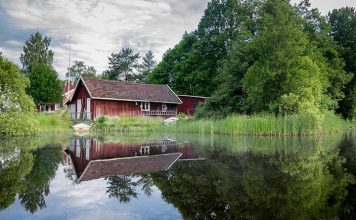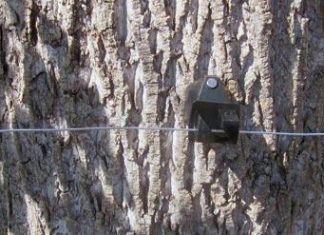| Issue #76 • July/August, 2002 |
I awoke last night to a circle of moonlight reflected on a wall. It was so vivid I could almost see the dark-and-light patterns of the moonface in the reflection. The light poured down from a skylight onto a curved expanse of pure white cotton and pale wooden lattice strips. A breeze blew and I could hear the walls moving softly, comfortingly. I looked out floor-to-ceiling windows into the forest and was content.
This is a typical moment of life in a yurta practical and magical structure.
A yurt may be for you if:
- You want a temporary place to live while building a homea place that can later be turned into an elegant and atmospheric art studio, guest house, meditation chamber, spa room, picnic shelter, playhouse, or workshop
- You’ve got property that’s hard to access with conventional building materials (an unassembled yurt can be floated in by raft, helicoptered in, hauled by horses, or driven to your property in one or two pickup loads)
- You have a seasonal property and want a structure you can take apart and store for part of the year, safe from vandals, bad weather, and off-season maintenance costs
- You like to feel close to nature while still being comfortably sheltered
- You want an inexpensive outbuilding that’s environmentally friendly and doesn’t look trashy
|
I haven’t forgotten my fellow Outlaws, either (although this article is somewhat different than my usual sort). A yurt is especially good for us because:
- It’s inexpensive enough to let you own a home without bank mortgages. You can set up a yurt for under $10,000. (Prices, including optional features, range from about $5,000 to $15,000, with a few thousand more for flooring, heat, and other necessities.
- If you buy from out of state, or within a state that has no sales tax, no government extortionists will profit off you.
- Because it’s not a permanent structure, a yurt also probably won’t increase taxes on your property. (But check for yourself.)
- With a yurt, you have the flexibility to relocate quickly, taking your home with you.
What exactly is a yurt?
A yurtbased on the traditional Mongolian nomad’s hutis a circular, peak-roofed dwelling with a wooden lattice wall. The roof consists of a large central ring with radiating rafters. Rafters and lattice wall are tied together by a cord that bears a remarkable responsibility for keeping the structure intact. The entire thing is then covered by a flexible skin.
In modern U.S.-manufactured yurts, skins are usually polyester-canvas or vinyl. High-tech insulation is an option (and a must for year-round living in most climates). The cord that holds the walls to the rafters is aircraft cable. The roof ring supports a skylight, or sometimes an outlet for a central chimney. Big, vinyl, detachable windows cover built-in screens.
Yurts may be up to 30 feet in diameter (around 730 square feet). They can be partitioned into rooms or left as one open living space. You can link two yurts together with a docking unit, or link a yurt to another building. Most are manufactured as kits, to be erected by you and your friends.
Me and my yurt
I had hoped to buy a 24-foot (450-square-foot) yurt. But when a used 18-foot model became available at a good price, I jumped at it, even though I feared it would be uncomfortably small. I was happily surprised. Because there are no wasted corners, that 263-square-foot (or rather, round foot) space gave me two years of comfortable living with room for my computer, futon, rocking chair, a kitchen area, a small bathroom, and beds for three large dogs. It now serves as an office and guest room, complementing a cabin not much larger than the yurt itself.
|
My yurt is ideal for year-round use since it features heavy-duty materials and an (optional) panel wall system that enables me to change the position of windows and walls to catch the light at different seasons, equalize the effects of weathering, add or remove a window, or easily replace a damaged section of skin.
But before my used bargain came along, I’d long been admiring the works of Pacific Yurts of Cottage Grove, Oregon (www.yurts.com/), the original U.S. yurt maker. They create a versatile, high-quality, affordable product, which has the advantage of having more have-it-your-way options than any other. And they have excellent customer service, as well.
You can get a list of suppliers by entering the terms “sustainable architecture” and “yurt” into an Internet search engine. Or you can build your own yurt from scratchwhich is what my neighbors did to create a home schoolhouse for their children. But I was glad to have the finished parts, instructions, and ready advice from the manufacturer.
Erecting the yurt
Setting up a yurt is simple. Once you know what you’re doing, you and two or three friends can erect a 30-foot yurt in two days, and a smaller yurt in a single day. It took me and one helper about 12 hours, with neither of us having any prior experience.
But first, you’ve got to have a deck or some other type of flooring. Everyone who’s ever built a yurt will tell you that’s the most time-consuming part.
Yurt makers will supply you with free deck plans and materials lists. Or they’ll consult with you about other types of flooring. The main thing to know is that your flooring or deck must be designed for the yurt you purchase, because each manufacturer has different size requirements and its own system for tying down the lattice walls and skin.
If you plan to move your yurt from place to place, you might want to make a portable deckperhaps as a series of wedges that can be bolted together. My helper and I constructed a deck from the manufacturer’s specifications. These specs made a deck that I swear is sturdy enough to drop from an airplane. If I were to do it again, I’d go for a lighter, more portable deck.
Construction
Each brand of yurt has a slightly different sequence of construction, but all are similar. With mine, we first bolted the door frame onto the edge of the deck. Then we assembled the lattice wall (which may come in two or three sections) and fastened it to one side of the door frame. As if stretching a baby gate across a doorway, we walked the lattice around the edge of the deck, fastened it to the other side of the door, then anchored it to the deck with metal brackets.
Spreading the lattice wall is probably the most fun part of the project. But because that big, wooden accordion is floppy, this is one step where it helps to have at least three people to keep it stable.
After that, I looped a circle of aircraft cable around the upper part of the wall. (It rests on spacers within the top “X” of the lattice.) The low ends of the rafters will notch onto this cable. My helper nailed a thin plywood strip around the bottom of the wall for appearance and weather protection. (On a Pacific yurt, this strip would be wider and the skin would attach to it.)
Next come the skylight ring and rafters. The ring has a series of holes encircling it. The upper ends of the rafters attach to the ring via pins inserted into the holes. The most intuitive way to raise the skylight is to “skewer” the ring with three or four strategically placed rafters, then have several friends hoist the assembly into the air until they can affix the lower ends of the rafters to the aircraft cable. At that point, you’d insert the remaining rafters. That’s the way you do it with some yurts.
The manufacturer of mine, however, strongly recommended tying the ring into place atop scaffolding and only then begin attaching rafters. That’s because their skylight ring is heavy and quite a work of art. You wouldn’t want to risk dropping it. But it wasn’t easy. Using the scaffolding, you must place the ring at exactly their proper height and position or the rafters will balk when you try to insert their pins into the ring.
|
My yurt came with three separate roof layers: an inner liner of 100 percent cotton canvas, an insulation layer (R-15) made of plastic “bubble” material sandwiched between aluminized outer covers, and the roof skin itself, a single unit made of tough vinyl fabric and weighing about 75 pounds.
One by one, with the liner first, we lifted these up through the skylight and spread them over the rafters. The outer skin was bulky and hard for two people to maneuver. This is another step at which three or four strong friends could be helpful. But even with some struggle, two of us managed to get the entire roof on in only about two hours.
Next you can tie a rope to the skylight and, while standing inside the ring on a ladder or scaffold, pull it up the side of the yurt, across the roof and into place, where it reattaches in seconds.
Finally, the walls. And they were a breeze.
Inside the drip-edge of the roof skin is another small metal cable. Wall insulation and wall skin simply clip to it and hang down, as if from a clothes line. My walls came in two layers; this time the inner cotton liner was built into the insulation panels (also R-15). With my yurt’s panelized system, I simply lifted the outer skin into place section by section, clipped it over the insulation, zippered the panels together, and closed big, weather-protecting velcro flaps over the zippers.
Once the skin was on and battened down to the sides of the door frame, all that was left was to tighten it around the bottom. In this case, that meant pulling a drawstring. With another design, you might screw the skin down through grommets.
Voila! A finished yurt.
As with any structure, you’ll need to decide on the type of plumbing, electricity, heat, and cooling you want.
Yurts lend themselves naturally to off-grid options like self-contained composting toilets and rainwater catchment systems (which Pacific Yurts, among others, offers). Wood stoves or pellet stoves will heat them efficiently. (You can order your kit with the needed flashings). Tankless water heaters work well in the limited space. And electric outlets can be set into the floor or installed on posts, or you can snake an all-weather extension cord under the walls from an outside box.
Some thoughts on yurt living
In a yurt, you’ll hear every raindrop, every breeze, every bird call and coyote howl. In high winds your yurt will rock and creak like a wooden sailing ship in a gale. Yet, while reacting strongly to every weather change, yurts handle weather brilliantly. I was inside one day when a 100-mph wind gust hit. The lattice wall swayed. My desk rolled backward, books tumbled from atop a filing cabinet. But when I checked for damage later, I found only that the drip-edge of the roof had harmlessly flipped upsomething I could have avoided by using the built-in tiedown loops. The roof and walls have never leaked, even in the worst rainstorm. The roof has never bowed under snow. And I’ve had only minor, fixable problems with cold and moisture penetrating around the bottom. If you’re living in areas of truly extreme conditions, wind and snow reinforcing kits are available.
The yurt is at its comfortable best when it’s 40 to 70 degrees F outside. But people happily use yurts in the high Rockies and Arizona deserts. You need to be sure you weatherize and heat or cool the yurt for your climate. Double insulation layers may be an option. A door that swings inward is a plus in a snowy climate, and you should check whether this is standard or optional on any yurt you’re interested in.
The outer wall of a yurt isn’t usually very tall6’2″ on mine. Because of the sloped roof, this has never been a problem. If you’re much over 6-feet, though, you may want to look into “tall-wall” and full-height door options. Short of that, make sure to build your entryway so that you have a step up to your door; this will help avoid bumped heads.
Get a skylight that’s openable, not fixed. I can’t tell you how important that is to airflow and cooling on hot summer days. The skylight is a big feature of yurt living, both for utility and beauty, and you’ll probably spend many hours admiring and appreciating it.
When you first begin looking at yurts, they all seem similar. But the difference is in the details. Check the thickness of the rafters, the weight of the fabrics and the window vinyl. Look carefully at the finishing details and the various hardware and connectors. Make a list of what’s optional and what’s standard. Examine the quality of the wood and other materials, and what’s natural and what’s synthetic. Get to know yurt vendors and yurt dwellers. Ask questions. Suddenly what looked like a basket of identical apples seems filled with oranges, quinces, and pomegranates. The yurts are that different.
No one really knows how long these manufactured yurts will last, since they haven’t been made that long. The oldest company, Pacific Yurts (est. 1978), has reports from customers whose 18-year-old yurts are still in fine shape. But a more realistic design life is probably 10 to 15 years, and that will vary depending on your use (or abuse) and climate.
Make your choice carefully, treat your yurt well, and you can enjoy many years of moonlight, breezes, and inexpensive, independent living in a structure that’s magical in its pleasures.



 My yurt came with three separate roof layers; an inner liner of cotton canvas, an insulation layer made of plastic “bubble” material, and the roof skin itself.
My yurt came with three separate roof layers; an inner liner of cotton canvas, an insulation layer made of plastic “bubble” material, and the roof skin itself. Every piece of my yurt fit into a small pickup truck. In the above photo you see the rafters on the bottom, then the lattice wall sections, the door unit (the sill is visible), and on top of everything, the skylight. Insulation panels and wall sections served as cushioning. Various hardware rode up front with me as I headed for my construction site.
Every piece of my yurt fit into a small pickup truck. In the above photo you see the rafters on the bottom, then the lattice wall sections, the door unit (the sill is visible), and on top of everything, the skylight. Insulation panels and wall sections served as cushioning. Various hardware rode up front with me as I headed for my construction site. The finished yurt can have many of the amenities of modern living including electricity and plumbing.
The finished yurt can have many of the amenities of modern living including electricity and plumbing.










